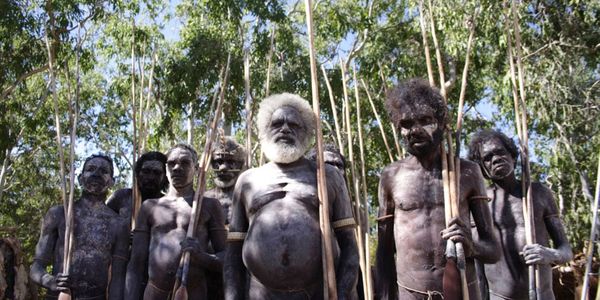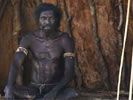Eye For Film >> Movies >> Ten Canoes (2006) Film Review
Ten Canoes
Reviewed by: Jeff Robson

The Aboriginal peoples have always played a prominent part in Australian cinema – but this is the first film I’ve seen that puts them centre stage.
Several directors have focused on their plight since the coming of the white colonists, yet even in sympathetic portrayals such as Rabbit-Proof Fence and The Chant Of Jimmy Blacksmith they are seen solely in relation to the European settlers.

Ten Canoes, on the other hand, takes us back a thousand years before the First Fleet. Using an entirely Native Australian cast (many of whom are not professional actors) and shooting completely on location, De Heer is clearly attempting a cinematic portrayal of the Aborigine neither as tragic victim or theme park ‘noble primitive’.
Of course, you can’t entirely ignore the box office, so the presence of David Gulpilil will undoubtedly be a big advantage in getting bums on seats. Probably the only Aboriginal actor most people could name, he’s turned in sterling performance in everything from Walkabout through Crocodile Dundee to The Tracker (his previous collaboration with De Heer). As a musician and performer he’s also been one of the standard bearers of Native Australian culture over the years and spends much of his time in his traditional homeland of the Arafura Swamp, in the far north of Northern Territory, where the film is set.
His love for this stunningly beautiful and remote land shines through from the first words of his voiceover. He never appears on screen but acts as a guide, chorus and, most importantly, storyteller as the film unfolds.
The story concerns a small group of men from the Yolngu tribe, engaged in the annual goose-egg gathering expedition. As they strip tree bark to make the titular canoes it becomes clear from their conversation that Dayindi (Jamie Gulpilil, who’s inherited a fair slice of his dad’s screen presence) is in love with the youngest wife of his much older brother, the white-haired expedition leader Minygululu (many of the cast have their real name and character name in common). To take the heat out of the situation the older man tells his brother an instructive tribal legend.
In true Aboriginal tradition the tale is poetic, discursive and several days long. As the hunters make their way to the swamp to gather the eggs we see flashbacks to an older time, where another younger brother, Yeeralparil (Gulpilil Junior again) feels the sap rising for the young bride of Ridjimiraril, a noted warrior and hunter. The tension is palpable but Yeeralparil does nothing except find more and more ludicrous excuses to swing by from the single men’s camp and catch a glimpse of his beloved, and life goes on as normal.
Until the arrival of a stranger from another tribe (Djigirr, whose role as co-director was to advise on tribal customs and liaise between crew and cast). The men of the village are alarmed, especially when he tells them he has magical objects to trade - the effect is similar to a drug-dealer gatecrashing a parish council meeting - and suggestions range from killing him to employing their own sorcerer to give the camp a clean bill of health. Soon after, another of Ridjimaril’s wives disappears...
The events that follow include accidental murder, self-sacrifice and tragedy. But it would be a mistake to dismiss this as a worthy but gloomy grinder that you ‘ought’ to go to see. De Heer succeeds in proving that, despite their way of life appearing utterly alien to the audience, these characters are not so different to us. They are often greedy, deceitful and morally flawed. But they also radiate compassion and good humour, getting through a hard and often dangerous life with love for their families and their land, and an awareness that even when you make your own law, there’s still a difference between right and wrong.
Dayindi’s life lesson is in the end less important than the film’s almost documentary-level immersion in a way of life that is basic, but neither simple nor impoverished. Admittedly, there are some longeurs and Gulpilil Senior’s narration isn’t always as sparkling and endearing as he seems to think it is. But these are minor quibbles. This is storytelling in its truest sense and the cast rise to the occasion; you wouldn’t guess they aren’t professionals, probably because they live these roles rather than acting them.
And did I mention that it looks absolutely stunning? De Heer and his cinematographer Ian Jones conjure up the vistas of swamp and forest, quiet and yet still teeming with life, superbly. The black and white camerawork used in the ‘framing’ story is equally effective. Inspired by a 1930s anthropologist’s photographs of (you’ve guessed it) ten canoeists, it reminds the audience that whatever our initial conceptions of these people were, they already had a history and culture going back millennia. It’s a privilege to share in it.
Reviewed on: 15 Mar 2007
















